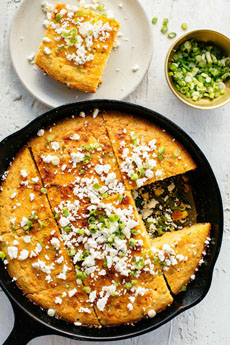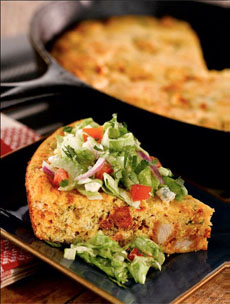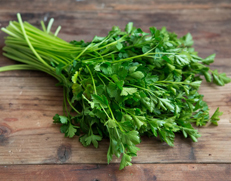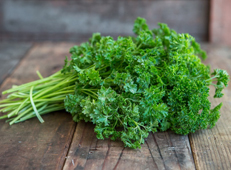TIP OF THE DAY: Cornbread With The Salad Course
|
|
Cornbread is a staple in the Southern U.S., and found not-often-enough in other regions. It can be plain or accented with popular mix-ins like corn kernels and minced jalapeños. It can be baked in a cake pan or a skillet. And it can be much more: Instead of simple, overly sweetened cornbread, we turn cornmeal into cornbread recipes layered with flavor: those corn kernels and jalapeños plus bacon, diced ham, fresh sage, scallions (green onions), shredded Cheddar or Jack cheese, sundried tomatoes and more. Today’s tip is to serve cornbread with the salad course: We have a fun and flavorful recipe below for Buffalo Chicken Cornbread. But first, some… Corn is native to Mexico, where the ancient peoples learned to grind the kernels into foods. Tortillas—flatbreads—were created. As corn spread from Mexico northward, it was cultivated by Native Americans across the southern region of what is now the continental U.S. European settlers learned to cultivate and cook corn from the Cherokee, Chickasaw, Choctaw, and Creek. They adapted cornmeal to European recipes: bread loaves and muffins, corncakes, corn pone (fried simply), fritters, hoecakes and pancakes, liquor, porridge and so on. Cornbread became popular as the main ingredient for a dressing or stuffing with fowl (the difference: stuffing is cooked inside the bird; dressing is cooked in a separate pan). It is now a staple at barbecue restaurants. |
|
|
Cornmeal is produced by grinding dried raw corn grains. The finest grind is used for baking, a medium grind for porridge and polenta, and a coarse grind for grits. Raw corn kernels spoked in hot water and an alkaline mineral like calcium hydroxide is called hominy (pozole in Spanish) and ground and mixed into masa harina, the dough used to make tamales and tortillas. Cornbread can be baked or fried, even steamed. Steamed cornbread is more like cornmeal pudding or mush, moist and chewier than a traditional bread. Here’s more on the evolution of cornbread plus early cornbread recipes. One thing to note: Originally cornbread did not contain sugar. As disposable income increased, this expensive ingredient was added as a variation, to make cornbread more like a cake. Unfortunately, more and more sugar was added until cornbread became an overly-sweet, simple bread. That’s fine if you want cake; you can serve sweet cornbread with berries and whipped cream. But if it’s bread you want, lose the sugar. We prefer to add whole corn kernels for sweetness, or enjoy cornbread as a savory bread. Finally: Is it cornbread or cornbread? Either spelling is fine. Many words evolve into compound nouns over time (bed room > bedroom, blue bird > bluebird, motor cycle > motorcycle, red head > redhead, under ground > underground and so forth. Maize is another word for corn. The only difference is in the word origin: |
||
|
RECIPE: BUFFALO CHICKEN CORNBREAD WITH BLUE CHEESE SALAD As an alternative salad course, top a “loaded” slice of cornbread with the salad. If you like blue cheese, this imaginative variation of cornbread was submitted by Sonya Goergen to the recipe section of the Lodge Manufacturing website. She uses a Lodge skillet, of course! You can serve cornbread and salad at brunch, as a soup-and-salad lunch, or as a salad course at dinner. Prep time is 20 minutes, cook time is 30 minutes. Ingredients For 8 Servings For The Cornbread |
|
|
|
Preparation 1. PREHEAT the oven to 400°F. Spray a 10-1/4” cast iron skillet with cooking spray. 2. COMBINE the egg, milk and oil in a medium bowl. Add the cornbread mix, Cheddar cheese, blue cheese, diced hot wings, red pepper flakes and cilantro. Stir until well blended and pour into the skillet, spreading evenly. 3. COOK for 20 to 30 minutes until golden brown. Remove from oven and let cool. 4. Combine the lettuce, celery, red onion and crumbled blue cheese in a medium bowl. Toss with the blue cheese dressing. Cut the cornbread into 8 wedges and divide the salad atop the portion. Garnish with diced tomatoes and cilantro and serve. There are numerous varieties of parsley, but flat leaf and curly are the varieties most often found at the store, and can be used interchangeably in recipes. The plant, native to the Mediterranean, is a member of the Apiaceae family, commonly known as the carrot, celery or parsley family. It is a family of mostly aromatic plants with hollow stems. Family members include angelica, anise, arracacha, asafoetida, caraway, carrot, celery, chervil, cicely, coriander (cilantro), culantro, cumin, dill, fennel, lovage, and parsnip, among others.
|
||






